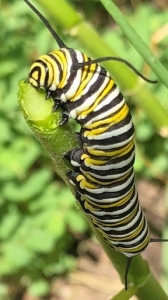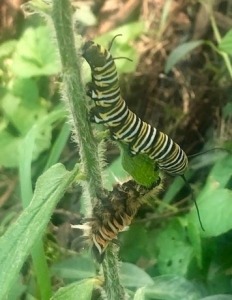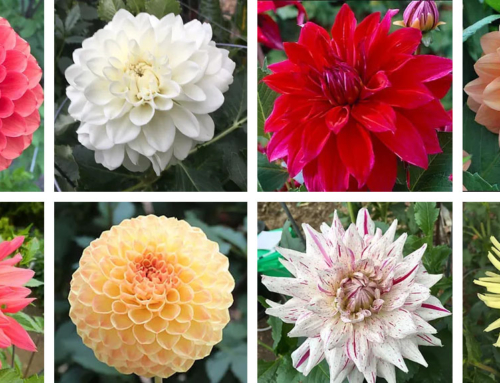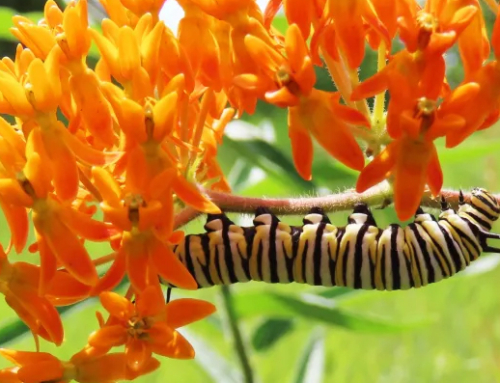I love butterflies, especially Monarchs, and while I knew basic information about them, I wanted to know more. Through the Minnesota “Master Naturalist” program, I signed up for a seminar on “Monarchs and Milkweeds” at the Minnesota National Wildlife refuge. During the day-long class, I learned that milkweed was their “host” plant. This means that it is the ONLY plant that Monarchs will lay their eggs on and the caterpillar will eat. We were also taught to identify and look for the tiny eggs, and how to recognize each of the five stages (“instars”), of the Monarch caterpillar. Information was also shared about raising a Monarch from egg to butterfly…I was hooked!

Since habitat is key to attracting Monarchs, I began to create a large native garden with four varieties of milkweed and many other nectar plants. Daily, I surveyed the garden for signs of eggs or caterpillars. If there were holes in the milkweed leaves, I knew it meant a caterpillar (“cat”) was voraciously eating. Checking some of the smaller milkweeds across the front of my house, I was amazed to count 27 bigger (4th -5th instar) caterpillars. The poor plants were almost denuded. I knew the caterpillars needed more milkweed, so I spent a couple hours moving each one to the backyard plants which were taller and more robust. I placed each “cat” on one of the milkweeds. I felt like a “monarch momma” trying to make sure each one of my “cats” would have enough to continue to grow. A few days later, I noticed that there were 26 chrysalises hanging from the upper boards of our garage. When the caterpillar reaches the 5th instar, it stops eating and crawls to another location. The caterpillar forms a tiny silken hook and hangs in a “J” form for 12-24 hours to form its chrysalis. They will hang there for about ten days…until the moment when the butterfly emerges to dry it’s wings and take to the skies.
Milkweed is the host for Monarchs…but did you know that there is another caterpillar that also seeks this plant?

One day I came across these weird caterpillars and I was really grossed out! They were devouring my milkweed one leaf at a time, feeding in colonies. It appeared that the entire leaf was undulating. After posting a picture of them on a listserv, I found out that these were the larval stage of the “Milkweed Tussock moth”, also known as a “Milkweed Tiger” moth, which is a native insect. The caterpillar starts out pale yellow and then develops long tufts of orange, yellow and black. They reminded me of “ANIMAL”, a wild haired puppet (muppet), from “Sesame Street”.
Both the Monarch and the Tussock moth caterpillar have similar coloration. In nature, these vivid shades of yellow, orange and black serve as a warning that they are unpalatable for the birds and other creatures that might want to make a meal of them.
While the Monarch turns into a dazzling orange and black butterfly, the Tussock moth caterpillar becomes a rather drab brown moth.
So what is it about Milkweed that is so important to these creatures?

Milkweed has a milky sap, which contains a chemical with a toxic cardiac glycoside element that can affect the heart. When caterpillars and other insects eat milkweed they store these chemicals in their bodies. A predator that may try to eat them will become violently ill. Birds and other predators quickly learn that they should avoid these creatures. The Milkweed tussock moth has also developed an organ that emits an ultrasonic signal detected by bats, (their primary predator), warning them that they should stay away.
Now that I know a bit more about Monarchs as well as the “other” milkweed caterpillar, I am even more determined to increase my efforts to provide a welcoming environment for all. The Monarch may still be my favorite but these curious “muppet” looking caterpillars have given me a broader understanding of the old adage:
“Beauty is in the eye of the beholder!”
My native garden will soon be certified as a “Monarch way-station”. I hope it will inspire others in my neighborhood to want to start helping these beautiful and diverse creatures.
More information about Monarchs can be found at:
monarchs@monarchjointventure.org
The Xerces Society Project Milkweed
https://monarchjointventure.org/our-work/partner-projects/monarch-habitat-certification-programs
More information about the Minnesota master naturalist program:
http://www.minnesotamasternaturalist.org
By Val McGruder




